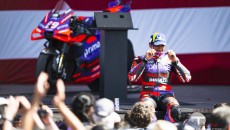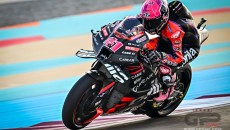The unexpected cancellation of the Qatar Grand Prix due to the closure of the Doha borders for Italian and Japanese citizens has undoubtedly created a lot of inconvenience, but as always also some opportunities.
Far from us wanting to create any controversy, but this is only an analysis of the facts and of what is happening or might happen from today until the first MotoGP race which is currently scheduled for April 5 in Austin, Texas.
The first thought, obviously, goes to those riders who, for physical or other reasons, were not completely ready to race. But while Marc Marquez, back from a not particularly successful shoulder operation, will be able to take advantage of four more weeks to get back to full strength, Andrea Iannone, on the other hand, who has been halted by the FIM and Wada over a suspected case of doping, is still waiting for a verdict which, if not favourable, will lead to an appeal to the CAS, resulting in a further postponement of the sentence.
Much simpler, and immediate, seems to be the case of any technical problems not yet solved or still to be resolved after the two MotoGP test sessions at Sepang and Losail.
In fact, all the teams will benefit from this further time extension to homologate, and therefore freeze, both the engines and the aerodynamic package.
The FIM regulations in fact stipulate that these must be homologated before the first event. This normally happens during technical checks on the Thursday before the Grand Prix.
The topic has already been covered by Motomatters which reminds us how:
The rules for engines are laid out in section 2.4.3.1.4.a of the FIM MotoGP regulations:
* An approved MotoGP engine is one which has all parts included within the seals (Art. 2.4.3.3.2) identical in every respect to the parts included within the seals of a sample engine delivered to the MotoGP Technical Director no later than close of Technical Control of the first event (...)
The rules for aerodynamics are set out in section 2.4.4.7.10.ii.a:
* The Aero Body is approved and samples or detailed drawings (to the satisfaction of the Technical Director) must be delivered to the Technical Director prior to the close of technical control at the first event of the season.
And the rules on gearbox ratios can be found in section 2.4.3.9.1.b:
* Teams will be required to declare all the gearbox ratios chosen for each gearbox speed before the first race of the season, and only these declared ratios may be used during the entire season. Any ratios not declared before the first race of the season may not be used during that season.
This being so, it is clear that, since the first event of the season - the Qatar GP - has not taken place, this must be considered the Grand Prix of the Americas in Texas. A possible contestation of this fact - that is, the first GP was held albeit without the MotoGP category - was denied by the MotoGP technical director, Danny Aldridge. So, the homologation and subsequent freezing of engines and aerodynamics must be understood as at the Austin GP ... if this takes place, otherwise it will be passed to the next one and so on.
Two teams are excluded from this rule: Aprilia and KTM, which however have the possibility of intervening on the engines due to the concession system allowed to those manufacturers that have not yet won a race.
Obviously, all the other official manufacturers benefit from this extension, even if it is a well-known fact that Honda in particular still need to do a bit more fine-tuning, judging by how competitive Yamaha and Ducati were on the Losail circuit.
It goes without saying, therefore, that HRC will be able to continue experimenting, but not with its official riders - the brothers Marquez and Cal Crutchlow - who are not allowed, but with its test riders and specifically with Stefan Bradl.
One month may not seem like a long period of time, especially if the deadline for a certain development had already been fixed, but it still offers a time extension that could be welcome.
The downside for those who were already in a good position, however, is that of having shown their cards to their rivals, for example aerodynamics or 'Holeshot 2.0' devices. Some manufacturers will now have more time to set them up, potentially nullifying one of their opponents' strengths.









